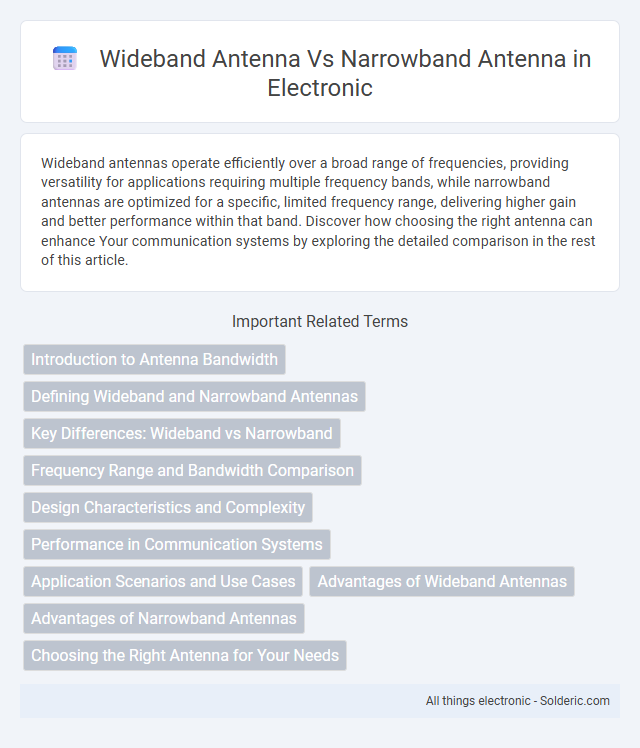Wideband antennas operate efficiently over a broad range of frequencies, providing versatility for applications requiring multiple frequency bands, while narrowband antennas are optimized for a specific, limited frequency range, delivering higher gain and better performance within that band. Discover how choosing the right antenna can enhance Your communication systems by exploring the detailed comparison in the rest of this article.
Comparison Table
| Feature | Wideband Antenna | Narrowband Antenna |
|---|---|---|
| Frequency Range | Broad, covers multiple frequency bands | Limited to a specific, narrow frequency band |
| Bandwidth | High bandwidth for versatile applications | Low bandwidth, optimized for single frequency |
| Application | Multiband communications, signal intelligence | Point-to-point communication, narrowband broadcasting |
| Size | Generally larger due to broad spectrum support | Typically smaller and simpler design |
| Gain | Moderate gain across wide frequencies | Higher gain at the tuned frequency |
| Complexity | More complex design and tuning | Simple design with fixed parameters |
| Cost | Usually higher due to advanced design | Lower cost and easier manufacturing |
| Efficiency | Efficient over broad spectrum with some loss | Highly efficient at narrow frequency |
Introduction to Antenna Bandwidth
Antenna bandwidth defines the range of frequencies over which an antenna operates effectively, with wideband antennas supporting a broader frequency range compared to narrowband antennas. Wideband antennas enable improved performance in applications requiring multi-frequency coverage, such as broadband communications and radar systems, whereas narrowband antennas provide enhanced gain and selectivity at specific frequencies, ideal for single-frequency transmissions. Understanding these bandwidth characteristics is crucial for optimizing antenna design and achieving desired communication system performance.
Defining Wideband and Narrowband Antennas
Wideband antennas operate efficiently across a broad range of frequencies, enabling versatile applications such as ultra-wideband communications and radar systems, whereas narrowband antennas are designed to function optimally within a limited frequency spectrum, ensuring high gain and selectivity for specific signal bands. The key distinction lies in bandwidth, with wideband antennas typically covering frequency ratios greater than 3:1, contrasting narrowband antennas that maintain a fractional bandwidth usually below 10%. This fundamental difference influences antenna design parameters such as impedance matching, radiation pattern stability, and application suitability in wireless communication.
Key Differences: Wideband vs Narrowband
Wideband antennas operate over a broad frequency range, providing greater flexibility for diverse communication applications, while narrowband antennas are designed for a specific, limited frequency range, offering higher efficiency and sensitivity within that band. Your choice depends on whether you prioritize versatility and multi-frequency use with wideband antennas or enhanced performance and reduced interference in a narrowband setup. Frequency bandwidth, impedance matching, and application requirements are key factors distinguishing wideband and narrowband antenna performance.
Frequency Range and Bandwidth Comparison
Wideband antennas cover a large frequency range, providing substantial bandwidth that supports multiple communication standards simultaneously, making them ideal for versatile applications. Narrowband antennas operate within a limited frequency range, optimized for specific signals, resulting in higher sensitivity and better performance at designated frequencies. Your choice depends on whether you need broad frequency coverage or concentrated signal strength for a particular frequency band.
Design Characteristics and Complexity
Wideband antennas are designed to operate efficiently over a wide range of frequencies, often requiring complex multi-resonant structures or broadband matching techniques to achieve consistent performance. Narrowband antennas typically feature simpler designs optimized for a specific frequency or narrow frequency range, resulting in higher gain and efficiency but limited flexibility. The increased design complexity of wideband antennas often involves trade-offs in size, fabrication precision, and material selection compared to the relatively straightforward implementation of narrowband antennas.
Performance in Communication Systems
Wideband antennas offer extensive frequency coverage, enabling improved performance in communication systems by supporting multiple channels and reducing signal interference. Narrowband antennas, while limited to a specific frequency range, provide higher gain and better sensitivity for targeted signal transmission and reception. Your choice between wideband and narrowband antennas depends on whether you prioritize versatile frequency operation or optimized signal strength for a particular communication system.
Application Scenarios and Use Cases
Wideband antennas excel in applications requiring multi-frequency operation, such as modern communication systems, spectrum monitoring, and military radar, where capturing wide frequency ranges is crucial. Narrowband antennas target specific frequencies, making them ideal for broadcast radio, satellite communication, and wireless sensor networks that demand optimized performance at a single frequency. Your choice between wideband and narrowband antennas depends on whether your use case demands broadband flexibility or precise frequency tuning.
Advantages of Wideband Antennas
Wideband antennas offer superior frequency range coverage, enabling Your device to operate efficiently across multiple bands without needing antenna changes. Their high versatility supports diverse communication standards such as LTE, Wi-Fi, and 5G, reducing hardware complexity and deployment costs. Enhanced signal resilience and improved data transmission rates make wideband antennas ideal for dynamic and modern wireless environments.
Advantages of Narrowband Antennas
Narrowband antennas offer superior performance in terms of gain and selectivity within a specific frequency range, making them ideal for applications requiring precise signal reception or transmission. Their design minimizes interference and noise, enhancing signal clarity and reliability for communication systems. You benefit from increased efficiency and optimized power usage when deploying narrowband antennas in targeted frequency bands.
Choosing the Right Antenna for Your Needs
Wideband antennas offer a broad frequency range, making them ideal for applications requiring versatility and multi-band operation, while narrowband antennas provide optimized performance and higher efficiency within a specific frequency range. Selecting the right antenna depends on your specific communication requirements, signal environment, and desired bandwidth. Understanding the trade-offs between frequency coverage and signal quality ensures your system achieves optimal performance and reliability.
wideband antenna vs narrowband antenna Infographic

 solderic.com
solderic.com